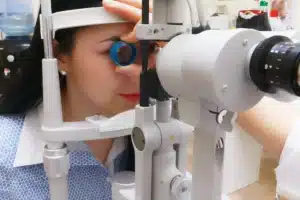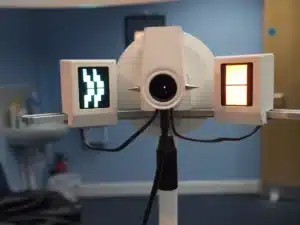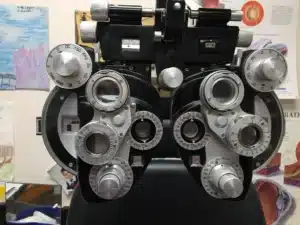The eye is made up of a number of different structures working together to give us the gift of sight. Two of the more important structures are the natural lens and the cornea. You can think of the natural lens as the innermost lens of the eye, while the cornea acts as the outermost lens.
The cornea, which is located on the front surface of the eye, is what light first passes through as it enters the eye. In fact, the cornea is responsible for nearly 65-75% of the eye’s total focusing power. It also protects the eye from dust, germs, bacteria, and other debris that could harm it.
The natural lens, which is located behind the iris and pupil, takes the light that originally passed through the cornea and focuses it into the retina (the back of the eye). The lens uses ciliary muscles to change shape when focusing on near or distant objects, helping us see clearly.

So, what is astigmatism?
Astigmatism is a condition of the eye that changes the way light rays pass through the cornea on their way to the retina. It’s caused by irregular curvature of the cornea or lens, which doesn’t allow light to focus properly. This generally results in distorted vision or blurred vision.
In order to focus light properly, the cornea must be evenly curved and shaped like a ball, but astigmatism occurs when it’s shaped more like an egg. In other words, the cornea should be shaped like a basketball, but with astigmatism, it’s shaped like a football.
You’ll generally hear it called either with-the-rule astigmatism, which is when the steepest curve runs vertically or against-the-rule astigmatism, which is when the steepest curve runs horizontally. Uncorrected astigmatism can reduce your quality of life and make it difficult to see.

Astigmatism Symptoms
While it’s not known what causes astigmatism or irregular curvature of the eye, we do know that it is often present at birth, and genetics likely play a large role in the formation of astigmatism. It also often occurs in patients with myopia (nearsightedness) or hyperopia (farsightedness).
With that said, astigmatism isn’t caused by reading in low-light conditions or sitting too close to the TV screen. Some of the most common symptoms of astigmatism include:
- Blurry vision
- Distorted vision
- Headaches
- Needing to squint for clear vision
- Difficulty seeing clearly at night
- Eye discomfort
- Eyestrain
In addition to excessive myopia and hyperopia, some of the most common risk factors of astigmatism include scarring or thinning of the cornea, a family history of astigmatism, eye injury or trauma, and eye surgery. Luckily for these patients, astigmatism is easy to correct.

Different Types of Astigmatism
There are several different types of astigmatism and understanding which one you’re suffering from is very important to finding the right treatment. Your eye doctor will perform a number of tests to determine what type of astigmatism it is and what treatment plan is best for you.
The two most prominent types of astigmatism include lenticular astigmatism and corneal astigmatism. It’s also possible for astigmatism to be present with other refractive errors. Let’s take a closer look at each type below.
Lenticular Astigmatism
Lenticular astigmatism is when the shape of your lens is distorted and looks more like a football, opposed to a basketball. With this type of astigmatism, the cornea is generally evenly curved.
Corneal Astigmatism
In contrast, corneal astigmatism is when the shape of your lens is distorted and resembles a football, opposed to a basketball. With corneal astigmatism, the lens is generally evenly curved.
Astigmatism With Other Refractive Errors
Astigmatism can also be present with another refractive error, defined as myopic astigmatism or hyperopic astigmatism. This means the patient has difficulty seeing near or distant objects.
Myopia, also known as nearsightedness, can cause the two curves to be focused in front of the retina. Hyperopia, or farsightedness, can cause the curves to be focused behind the retina.

How Do You Diagnose Astigmatism?
Developing astigmatism can be troublesome when it starts to impact your ability to see clearly, but your eye doctor can successfully detect astigmatism with a comprehensive eye exam. That’s what makes regular eye exams extremely important to overall eye health and function.
To receive an astigmatism diagnosis, your doctor will run several tests and use a number of instruments — including a visual acuity test, refraction test with an autorefractor, keratometer, and corneal topography to measure the cornea’s curve, and a phoropter to see the lens’ shape.
These tests are very common and are usually performed during any comprehensive eye exam to rule out the development or presence of astigmatism. Even if you’re not experiencing any symptoms, your eye doctor will be able to detect and diagnose astigmatism in its early stages.

Astigmatism Treatment Options
There are a number of ways your ophthalmologist can correct astigmatism and help you see clearly — the way it was supposed to be from the beginning. For example, LASIK, LASEK, PRK, Epi-LASIK, and SMILE are some of the most common types of surgeries for astigmatism.
In addition to refractive surgery, correcting astigmatism — whether it’s moderate astigmatism or severe astigmatism — can also be done with contact lenses or eyeglasses. Eyeglasses with corrective lenses are the easiest solution, while contacts require more daily effort by the patient.
Rigid contact lenses used to be the only type of contact lenses used to treat astigmatism, whether it be RGP (rigid gas-permeable) or GP (gas-permeable), there’s a new sheriff in town — soft, toric contact lenses or toric intraocular lens (with cataract surgery).
Contact Milwaukee Eye Surgeons Today!
Do you believe you’re suffering from astigmatism? Has it been a while since your last eye exam? Are you worried about the health or function of your eyes? Don’t worry, a trip to Dr. Ken Weinlander’s office helps you better maintain eye health and function for improved long-term vision.
Contact Milwaukee Eye Surgeons today to schedule your next comprehensive eye exam and put yourself in a better position to see clearly. We can’t wait to help you with all of your eye care needs!


